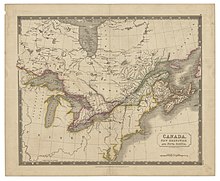Atlantic Canada
Atlantic Canada
Provinces de l'Atlantique (French) | |
|---|---|
 Atlantic Canada (red) within the rest of Canada | |
| Country | Canada |
| Composition | |
| Most populous municipality | Halifax |
| Area | |
| • Total | 488,000 km2 (188,000 sq mi) |
| Population (2021) | |
| • Total | 2,409,874 |
| • Density | 4/km2 (10/sq mi) |
| Time zones | |
| The Maritimes and Labrador | UTC-4:00 (AST) |
| Newfoundland | UTC-3:30 (NST) |
Atlantic Canada, also called the Atlantic provinces (French: provinces de l'Atlantique), is the region of Eastern Canada comprising four provinces: New Brunswick, Newfoundland and Labrador, Nova Scotia, and Prince Edward Island. As of 2021, the landmass of the four Atlantic provinces was approximately 488,000 km2 (188,000 sq mi), and had a population of over 2.4 million people. The term Atlantic Canada was popularized following the admission of Newfoundland as a Canadian province in 1949. The province of Newfoundland and Labrador is not included in the Maritimes, another significant regional term, but is included in Atlantic Canada.
History
[edit]
The Atlantic Provinces are the historical territories of the Mi'kmaq, Naskapi, Beothuk and Nunatsiavut peoples.[1][2][3][4] The people of Nunatsiavut are the Labrador inuit (Labradormiut), who are descended from the Thule people.[4] Acadia, a colony of New France, was established in areas of present day Atlantic Canada in 1604, under the leadership of Samuel de Champlain and Pierre Dugua, Sieur de Mons.[5] The French would form alliances with many indigenous groups within Atlantic Canada, including the Mi'kmaq of Acadia, who joined the Wabanaki Confederacy, important allies to New France.[6]
In 1713 the Treaty of Utrecht was signed between Britain and France where France ceded Nova Scotia and its claims to Newfoundland and territories in Rupert's Land.[7][8] Between 1755 and 1764 during the Seven Years' War the British forcibly removed thousands of Acadians from Nova Scotia and New Brunswick in an event known as the Great Expulsion or Le Grand Dérangement.[8][9]
The first premier of Newfoundland, Joey Smallwood, coined the term "Atlantic Canada" when the Dominion of Newfoundland joined Canada in 1949.[10] He believed that it would have been presumptuous for Newfoundland to assume that it could include itself within the existing term "Maritime provinces," which was used to describe the cultural similarities shared by New Brunswick, Prince Edward Island, and Nova Scotia, which entered Confederation during the 19th century (New Brunswick and Nova Scotia were founding members of the Dominion of Canada in 1867, and Prince Edward Island joined in 1873).[11]
Geography
[edit]Atlantic Canada is characterized by its rugged coastlines, gravel beaches, and dense forests.[12] Bordered by the Atlantic Ocean to the east and south, the region's maritime environment has profoundly influenced the regions climate, culture, and economy.[12] The area encompasses a mix of urban centers like Halifax and St. John's and rural communities that rely on fishing, and tourism.[12]
Although Quebec has a physical Atlantic coast on the Gulf of St. Lawrence, it is generally not considered an Atlantic Province; instead, it is classified as part of Central Canada, along with Ontario.[13]
Atlantic and Central Canada together are also known as Eastern Canada. Atlantic Canada includes a section of the Appalachian Mountains known as the Appalachian Uplands.[14] In each Atlantic province, Upland regions have been divided into three highland areas. The mountain range results in coastal regions being fjorded. Some areas contain glaciofluvial deposits.[15][16]
Economy
[edit]Atlantic Canada's primary natural resource industries include fishing, hydroelectricity, forestry, and mining.[17] The Atlantic provinces contribute to around 75% of Canada's fish production, with many coastal communities primarily dependent on fisheries.[18] The access point for many of such fisheries being the Gulf of St. Lawrence and the Atlantic continental shelf.[19]
Nova Scotia produces 75% of Canada's gypsum. Salt and iron is also mined in the Atlantic provinces.[20][17]
See also
[edit]References
[edit]- ^ "Welcome". Native-Land.ca. Retrieved 2023-11-11.
- ^ "Mi'kmaq". www.thecanadianencyclopedia.ca. Retrieved 2023-11-11.
- ^ "Innu (Montagnais-Naskapi)". www.thecanadianencyclopedia.ca. Retrieved 2023-11-11.
- ^ a b "Nunatsiavut". www.thecanadianencyclopedia.ca. Retrieved 2023-11-11.
- ^ "History of Acadia". www.thecanadianencyclopedia.ca. Retrieved 2023-11-11.
- ^ "Wabanaki". 2011-07-19. Archived from the original on 2011-07-19. Retrieved 2023-11-12.
- ^ Reid, John G., ed. (2004). The "conquest" of Acadia, 1710: imperial, colonial, and aboriginal constructions. Toronto ; Buffalo: University of Toronto Press. ISBN 978-0-8020-3755-8. OCLC 51923070.
- ^ a b Laxer, James (2006). The Acadians in search of a homeland. S.l.: Doubleday Canada. ISBN 978-0-385-66108-9.
- ^ Grenier, John (2008). The Far Reaches of Empire: War in Nova Scotia 1710–1760. University of Oklahoma Press. ISBN 978-0-8061-3876-3. Archived from the original on April 3, 2023. Retrieved December 11, 2018.
- ^ "Provincial Government: The Smallwood Years, 1949-1972". www.heritage.nf.ca. Retrieved 2023-11-11.
- ^ "Confederation | The Canadian Encyclopedia". www.thecanadianencyclopedia.ca. Retrieved 2023-11-11.
- ^ a b c Bone, Robert M. (2008). "Atlantic Canada". The regional geography of Canada (4th ed.). Don Mills, Ont. ; New York: Oxford University Press. ISBN 978-0-19-542536-9.
- ^ Immigration, Refugees and Citizenship Canada (2009-09-01). "Discover Canada - Canada's Regions". www.canada.ca. Retrieved 2023-11-11.
- ^ "Social Studies | Regions of Canada | Atlantic Region". gradefive.mrpolsky.com. Retrieved 2023-11-11.
- ^ Government of Canada, Natural Resources Canada (2016-09-12). "Natural Resources Canada. The Atlas of Canada. Physiographic Regions of Canada". atlas.gc.ca. Retrieved 2023-11-11.
- ^ "Geography of Newfoundland and Labrador". www.thecanadianencyclopedia.ca. Retrieved 2023-11-11.
- ^ a b "Natural Resources in the Atlantic Provinces". www.thecanadianencyclopedia.ca. Retrieved 2023-11-11.
- ^ "Fisheries | The Canadian Encyclopedia". www.thecanadianencyclopedia.ca. Retrieved 2023-11-11.
- ^ "Natural Resources in the Atlantic Provinces". www.thecanadianencyclopedia.ca. Retrieved 2023-11-11.
- ^ "Gypsum | The Canadian Encyclopedia". thecanadianencyclopedia.ca. Retrieved 2023-11-11.
Further reading
[edit]- Hamilton, William Baillie (1996), Place names of Atlantic Canada, University of Toronto Press, ISBN 0-8020-0471-7
- MacEachern, Alan Andrew (2001), Natural selections: national parks in Atlantic Canada, McGill-Queen's University Press, ISBN 0-7735-2157-7
- Martinez, Andrew J; Martinez, Candace Storm (2003), Marine Life of the North Atlantic: Canada to New England, Aqua Quest Publications, ISBN 1-881652-32-7
- Prieur, Benoit (2005), Atlantic Canada, Ulysse Travel Publ, ISBN 2894647239




